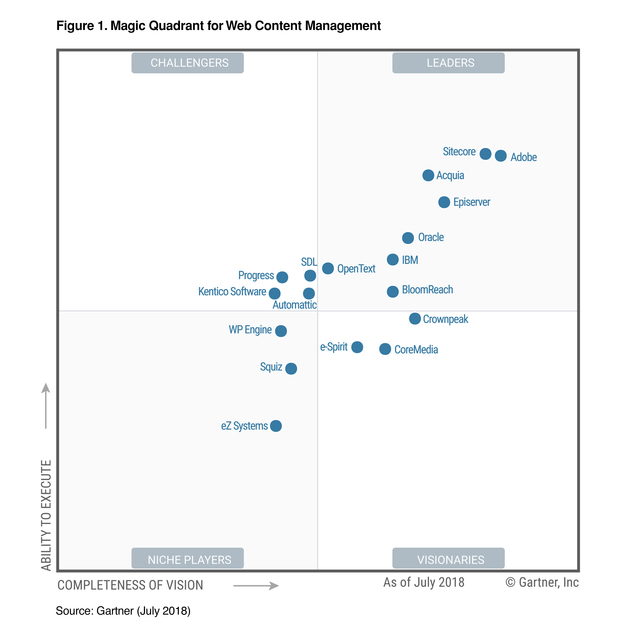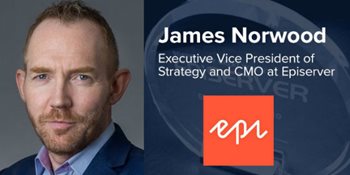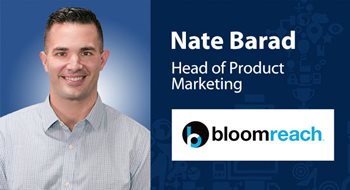Vendor Insights on Gartner Magic Quadrant for WCM 2018
By Laura Myers
September 21, 2018
Acquia, BloomReach, CaaS, CoreMedia, Digital Experience, Digital Strategy, Episerver, e-spirit, gartner, kentico, MQ, Progress Sitefinity, SDL, sitecore, WCM, Web Content Management
Earlier this summer, Gartner released its annual Magic Quadrant for Web Content Management 2018,  showing us where the perennial players placed this year compared and who joined the ranks of WCM platforms that are leading the way in innovation and execution.
showing us where the perennial players placed this year compared and who joined the ranks of WCM platforms that are leading the way in innovation and execution.
If you’re at all unfamiliar with the Magic Quadrant and why a notable ranking is so important to vendors, it all comes into focus when you understand the utility of the report as decision makers narrow down which system will serve their own digital needs in a variety of categories Gartner reports on.
When it comes to WCM, Gartner makes an important point that standout platforms should do more than just control content as it moves across a variety of channels. To name a few, it also needs to have additional functionality with regard to content creation and on-demand deployment, the provision of content metadata and the capabilities to support interoperability with all the systems organizations have in place to run their entire digital strategy at peak performance.
It is also important for tech buyers to understand what each axis means in relation to a vendor position and how to apply that understanding to their own unique needs. Within the report you can read a much more detailed description of each axis but here I will offer a high level overview.
Starting with the vertical axis, the Ability to Execute is an evaluation of each vendor as a business. Gartner takes a 360 degree look at how the vendor operates, how they market themselves, what the market itself is commonly saying about the vendor, and take into account the experience the vendor offers its own customers.
The horizontal axis, the Completeness of Vision, looks at the long game so to speak, evaluating the future potential for both the platform and the vendor. This is done by looking at a number of factors like marketing strategy based on an understanding of current and future market needs, how the product evolves in relation to those needs, logic of the organization's business model, strength of innovation etc.
What’s Different in Gartner MQ for WCM 2018?

While Sitecore and Adobe have stayed relatively put this year, they have company in their little corner of the Leaders quadrant as both Acquia and Episerver see their blue dots rise as a result of productive years for both organizations. BloomReach is another vendor to see their star rise as a Leader while we see Crownpeak welcomed as a newcomer to the coveted Leader’s quadrant.
SDL remains firmly on the edge of the Challengers quadrant well on their way to becoming a Leader next year if they can maintain their momentum with regard to completeness of vision. Kentico is also gaining ground in the same regard, neck and neck with Progress. e-Spirit enjoyed a significant jump along the same horizontal axis seeing their position change from a niche player to a visionary in 2018 and we see CoreMedia hold firm to their visionary status in their ninth consecutive year of recognition in the report.
An insightful characteristic of the report is the way Gartner lists both strengths and cautions of each vendor, allowing decision makers to understand the nature of a system in relation to their own digital maturity and overall strategy. This attribute of the report is exactly what I focused my questions on when I was able to interview a handful of featured vendors in the report, allowing them to elaborate on Gartner’s evaluation of their platform. Follow along below to read some of my conversations, for the full written interviews, simply click here or on each vendor's headline.
Speaking with James Norwood, CMO and EVP of Strategy at Episerver I first touched on the  commendation in the report saying Episerver maintains a notion of being more business-savvy in a ‘favorable contrast’ to other platforms on the market that are much more technology-driven. Having heard from customers in the past that Episerver does a great job of directly satisfying their business needs, I asked James about the specific business trends that drive Episerver’s product strategy.
commendation in the report saying Episerver maintains a notion of being more business-savvy in a ‘favorable contrast’ to other platforms on the market that are much more technology-driven. Having heard from customers in the past that Episerver does a great job of directly satisfying their business needs, I asked James about the specific business trends that drive Episerver’s product strategy.
“When companies are looking for new platforms, it is because they are looking to solve a need in their organizations and fill in experience gaps their customers may be having and that’s why packaging based on business needs is so critical. We appreciate being recognized for our focus on empowering the people who actually use our product.
By giving access to complex systems that are easy to use, we’re helping our customers realize some of the bigger trends such as artificial intelligence (AI), personalization, and the growth of engagement channels (such as voice) and IoT-enabled devices, all of which play a critical role in delivering a seamless customer experience. With the wrong technology, these trends can make an organization even more confused and disjointed.
A recent report found that the global business value derived from AI is expected to increase to $1.2 trillion this year (70 percent increase from last year) and that AI-derived business value in 2022 could be as high as $3.9 trillion. Episerver has implemented powerful artificial intelligence to back its three pre-packed solutions: Individualized Content, Experience-Driven Commerce and Intelligent Campaigns. Through AI, Episerver is also able to deliver personalization capabilities that enable client experiences to stand out and meet customer expectations. Shoppers are comfortable with personalization. In fact, 87 percent of online shoppers are okay with companies knowing more about them and state when a brand personalizes experiences, a quarter of shoppers are more likely to purchase from the brand again.”
Gartner also commented that Episerver struggles with brand awareness and presence in the market compared to its closest competitors, saying this is evident in how they appear less often on technology buyers’ shortlists than other Leaders in the quadrant “even when Episerver is a suitable choice”.
As an aside, since the release of the report, on September 6th Episerver announced they had reached an agreement to be acquired by Insight Venture Partners at a valuation of USD $1.16 billion with a focus of accelerating their product innovation, go-to-market sales & marketing initiatives and enhancing their efforts to bring more awareness to the brand.
In speaking with James prior to the announcement, I brought up their lack of brand awareness in the WCM market itself but also knowing how strong their platform is across a few other categories and, their push in the last couple years into the eCommerce market specifically, I asked if this statement by Gartner was more of a reflection of their better fit for customers who prefer a more consolidated system outside of just WCM?
"Episerver is proud of its WCM roots. Our decades of experience helped us envision and bring to market the idea of Experience-Driven Commerce – that goes beyond transactions and into totality of the digital experience with a brand. Whereas others are trying to consolidate their systems, Episerver is already there – unifying content, commerce and marketing on one single interface. A recent independent study proves that our customers are decidedly more productive and profitable when running their commerce businesses on Episerver. In fact, our digital commerce customers realize a 443 percent ROI over three years according to this research. These are homerun figures that cannot be ignored.
As a company that celebrates transparency, we’ve long understood the incredible value that third-party validators provide. We’re working hard to continually be recognized by analysts and experts as not only product categories mature but as we grow too. We have earned both consecutive and inaugural placements in a number of analysts reports recently, (Digital Commerce, DXP, Personalization Engines, etc.) emphasizing that Episerver is not only a suitable choice, but that we have the capabilities to compete across all categories."
 For Episerver's full written interview click here.
For Episerver's full written interview click here.
BloomReach, a newcomer to last year’s report following their acquisition of the Amsterdam-based open- source Hippo CMS enjoyed a second year in the Leader’s quadrant as one of two open-source providers. They’ve had a busy year adding a couple Silicon Valley regulars to their executive team in hiring David Hurwitz as CMO and Dave Pomeroy as CFO but to gain insight into their position in the Gartner Magic Quadrant for WCM this year, I spoke again to their other new addition Nate Barad, Head of Product Marketing at BloomReach
source Hippo CMS enjoyed a second year in the Leader’s quadrant as one of two open-source providers. They’ve had a busy year adding a couple Silicon Valley regulars to their executive team in hiring David Hurwitz as CMO and Dave Pomeroy as CFO but to gain insight into their position in the Gartner Magic Quadrant for WCM this year, I spoke again to their other new addition Nate Barad, Head of Product Marketing at BloomReach
In the report, Gartner makes note of BloomReach’s UI as a differentiating factor for the platform in comparison to others on the market but also that it elevates the system to a DXP through its quality, consistency and reduced complexity. I asked Nate where this ease of use and flexibility come from and what it means to BloomReach for Gartner to also recognize their strengths in AI and being API-first.
"We have the benefit of agility and velocity in what we build and a top priority is to make simple out of the complex, and make it nice to look at and use. For Gartner to recognize this highlights that people are asking about it, and customers desire an alternative approach.
This same philosophy of making simple out of complex is true in our developers' experience as well. A critical requirement of managing digital experiences is connecting customers with a business digitally. All businesses run differently and manage their brands uniquely, our DXP must be equally as flexible. An API first approach means we build with our tools the same way our customers and partners would. To make the right configuration for a user or a customer is the difference of a win."
One suggestion Gartner did make for decision makers is to scrutinize BloomReach’s ability to support their industry as they note in the report the organization needs to employ a more horizontal strategy when it comes to their growth within various markets and partner channels. I brought this up with Nate to ask how they felt about this suggestion and he made the point they enjoy decision makers taking such a close look at their platform.
"We welcome the scrutiny on all of our products and services. What we've built has been adopted at an incredible rate by certain sectors such as tourism and online retail, which are high-touch industries especially with digital. We are proud of our customer base and the amazing digital transformations they've made. Cedar Fair and their digital theme park apps come to mind immediately. That said we are always developing for other scenarios and other audiences of users. Our partner channel is growing, we've added several talented people, and you will see the results each year, including 2018."
 For BloomReach's full written interview click here.
For BloomReach's full written interview click here.
As the other open-source provider listed in the Leader category of this year’s quadrant, 2018 is Acquia’s  fifth consecutive appearance in the report. In previous years, Acquia’s unique combination of API-first delivery paired with secure cloud deployment has made the difference in their momentum as an organization, but this year Gartner makes mention of their power of community.
fifth consecutive appearance in the report. In previous years, Acquia’s unique combination of API-first delivery paired with secure cloud deployment has made the difference in their momentum as an organization, but this year Gartner makes mention of their power of community.
To start things off with my questions for Matt Kaplan, SVP of Product at Acquia I focused on the authors of the report highlighting the Drupal community as a contextual differentiator for the platform when customers are evaluating potential suitors, stating the community itself is “symbiotic, effective, influential and synergistically directional.” I asked Matt to go a little more in-depth on how the Drupal community influences their product and how they hope their product influences the community.
"Acquia is extremely proud of its Drupal roots and believes our investment in open source has been one of the strongest advantages to accelerating our innovation and helping drive adoption within the enterprise space.
Our origins in open source have largely influenced our approach of innovation through integrations and open platforms, and connecting our customers to a larger community. We’re building a powerful platform solution that helps brands create unified customer experiences using the best marketing technology available. The Acquia Experience Platform leverages the power of Drupal and provides a means to more easily integrate third party marketing and technology products. We believe excellence across every aspect of customer experience simply cannot be created by one vendor alone.
Acquia has many team members who contribute directly to Drupal and maintain open source applications. We make significant investments in Drupal development through a team of dedicated core contributors. We also support and curate Acquia Lightning, an open source distribution of Drupal that makes it easy for organizations to get development projects started quickly. Furthermore, Acquia has funded major Drupal community development projects and provide financial support to developers and maintainers in the Drupal community. We also established the Drupal 8 Module Acceleration Program to speed the delivery of key Drupal 8 modules for a variety of applications."
As a caution, Gartner emphasized that Acquia was lagging behind their closest competitors in terms of their messaging and positioning within the market. They also maintained that in their continued conversations with customers, there wasn’t enough understanding of what differentiators Acquia could provide in relation to the larger Drupal community. I wanted to hear from Matt how Acquia planned to address this.
"Acquia debuted in the marketplace as the enterprise guide to Drupal, but since then our value proposition and offerings have expanded significantly. From our origins in WCM, Acquia has grown to be a leading platform for digital experience management, relied upon by thousands of global brands including AMD, Wendy’s, Wilson Sporting Goods, Xerox and more. The Acquia Experience Platform differs from traditional WCM by:
- Enabling seamless support for multi-channel experiences that “scale with you”
- Speeding time to value and ROI of rich, interactive experiences
- Improving productivity for all stakeholders (developers, operators, digital marketers, authors)
- Uncovering insights and automates actions to improve business outcomes
You’ll see our new story reflected in everything we do, from our all-new website and our recent debut of some short product-line videos. These are just some of the ways we’re making our story clearer, so the market can understand the benefits Acquia can provide to help them keep pace with today’s burgeoning martech landscape."
 For Acquia's full written interview click here.
For Acquia's full written interview click here.
In 2018, SDL likely has their prowess in a global market understanding to thank for their positive move  along the Completeness of Vision axis. In fact, this is what I brought up with Arjen van den Akker, Product Marketing Director at SDL after reading Gartner’s emphasis on SDL’s unique ability to gain ground in markets that are hard for other vendors to penetrate like China and Japan, and asked how they were able to achieve both a presence and a potential for themselves where other WCM systems haven’t been as successful.
along the Completeness of Vision axis. In fact, this is what I brought up with Arjen van den Akker, Product Marketing Director at SDL after reading Gartner’s emphasis on SDL’s unique ability to gain ground in markets that are hard for other vendors to penetrate like China and Japan, and asked how they were able to achieve both a presence and a potential for themselves where other WCM systems haven’t been as successful.
"There’s no doubt that we’re seeing global interest and growth for SDL Tridion DX, our content management and digital experience solution. Largely from companies looking to develop their business on the international stage, and in particular in the Asia Pacific region.
Take China. Despite representing the globe’s largest retail economy, China remains one of the world’s most challenging markets to penetrate. Brands must firstly overcome language barriers and understand cultural nuances. They must also deal with tough censorship regulations – where certain foreign content is blocked by the “Great Firewall of China” – and they also need to apply locally for an ICP (Internet Content Provider) license before being allowed to run a website. And once local hosting, and domain names are registered, brands then need to ensure that digital content is always available to customers across any digital device. That’s incredibly complex for any global brand who isn’t already present in the region. Our strategy addresses real life problems like these. As an example, we recently announced a strategic partnership with Alibaba Cloud, and a co-developed solution that removes all the challenges behind registering, launching and developing a digital brand in the region."
In my understanding of the WCM market, SDL has always been synonymous with advanced abilities in both natural-language processing and natural-language generation but interestingly, Gartner marks their investment on these and other less-obvious aspect of WCM like delivery architecture as a caution of the platform. I wanted to know from Arjen why SDL has done things a bit different in having this focus and what they thought of Gartner’s comment.
"We have been focusing heavily on our delivery architecture, because we wanted to solve one of the biggest problems brands face today: the discontinuity of customer journeys between marketing content, commerce and in-depth product information. Since these different types of content are created and managed by different internal teams, the end result is a fragmented digital experience that reflects these internal organizational silos.
Our delivery architecture solves this problem by being able to ingest content from various backend systems, and then deliver it in a single, joined-up digital experience. That means that engaging marketing content and transactional commerce capabilities (managed via SDL Tridion Sites) can be blended with in-depth product information (managed in SDL Tridion Docs using DITA content), all on the same webpage. One of the ways to bring content together dynamically is through the use of taxonomies, which has been a feature of our solutions for many years.
In terms of NLP, the customers we tend to work with are multinational brands, dealing with millions of content hungry customers across dozens of countries and languages. They’re creating content around the clock – from web pages, to product and campaign-related content. If you think about it, language and linguistics sit at the very center of all of this. And this is where NLP and machine learning can really help.
Our firm belief is that companies can only deliver customer journey continuity by getting both their digital experience and language strategy right. At SDL we are committed to delivering the industry’s best solutions that combine these two areas, and we’re also investing heavily across other important aspects that companies are looking for in a next-generation web content management platform."
 For SDL's full written interview click here.
For SDL's full written interview click here.
It’s a well-known pain point for WCM customers to bite off more than they can chew with a platform.  Whether it’s being upsold a product with more functionality than they need or just a lack of digital maturity within their team, organizations struggle to get a full ROI from their system simply because they might not know how to use it is in the most effective way. Gartner acknowledges this in its comments on Sitecore saying customers in general ‘often pay a great deal for features they rarely use’ and through their training and best practice programs Sitecore sidesteps this with their own customers. When I got to speak with Ryan Donovan, Chief Technology Officer at Sitecore I asked him to give me some examples of these initiatives.
Whether it’s being upsold a product with more functionality than they need or just a lack of digital maturity within their team, organizations struggle to get a full ROI from their system simply because they might not know how to use it is in the most effective way. Gartner acknowledges this in its comments on Sitecore saying customers in general ‘often pay a great deal for features they rarely use’ and through their training and best practice programs Sitecore sidesteps this with their own customers. When I got to speak with Ryan Donovan, Chief Technology Officer at Sitecore I asked him to give me some examples of these initiatives.
"As any marketer or IT professional can attest, building an engaging digital experience requires a team of people to connect the dots between what is both a technical discipline and a creative pursuit. It’s with this in mind that Sitecore Business Optimization Strategies (or SBOS, for short) is often called our “secret sauce.” The SBOS team is borne out of a customer-centric culture that is 100-percent dedicated to improving customer experiences, which ultimately leads to higher ROI for the businesses employing it.
SBOS is just one of the capabilities we bring to bear for our customers under the umbrella of Sitecore Value Realization Services, though. Sitecore also offers a variety of Technical Consulting packages—what we call Stepstone—that help our customers achieve higher implementation quality and maximize the value of their investment. These services can include a review of the customer's implementation at each stage of the project lifecycle to ensure optimal implementation aligned to recommended practices, all the way through to collaborating with the customer's internal and external teams to define their architecture at the content, application, and system level."
Interestingly though, one of the things Gartner states as caution for Sitecore is its long and often complex implementation and deployment time, noting they often hear customers’ feedback on insufficient support through development and design and an inconsistency when it comes to the implementation quality from Sitecore partners. I gave Ryan the opportunity to address these concerns and state how they were working to better this in the future.
"The majority of Sitecore implementations are managed primarily by the Sitecore Solution Provider network, and we absolutely recognize that the services they deliver—in conjunction with us—have an outsized weight on our customers’ overall satisfaction with Sitecore. To make sure we’re collectively delivering exceptional results for our customers, we’ve made a number of adjustments to the program to provide our valued partners with the resources and support they need. I should say that, on the one hand, we’ve redefined what it means to be a partner and raised our expectations at every tier in the program. But just as important, we’ve increased our commitments and focused our investments to better support the skill development, certification, and successful application of Sitecore best practices that result in a delighted customer.
We also know that sometimes customers need or want to work directly with Sitecore, particularly in those instances when customers opt to implement with in-house teams without a partner. As I noted earlier, Sitecore continues to provide the Technical Account Manager role and Sitecore Value Realization Services delivers a blend of technology and digital marketing expertise that complements our partners’ capabilities. Our efforts to further reduce the barrier to entry and accelerate customer time-to-value also extend to our product capabilities, such as the Helix/Habitat best practices framework, Sitecore Experience Accelerator (which offers an out-of-box configurable solution), and JavaScript Services, which allows Sitecore solutions to be natively built in JavaScript. Finally, Sitecore is doing more than ever to measure and report on our partners’ success. We’re now using an independent third-party to survey joint customers and collect detailed customer feedback about the experiences and business outcomes related to Sitecore solutions and associated services. We review those results with our partners as part of our ongoing strategic planning processes."
 For Sitecore's full written interview click here.
For Sitecore's full written interview click here.
It is well known that a tablestake requirement for entry into this report is a firm grasp on market trends  and a transparency in how they’re used to influence the product strategy. This makes Gartner’s commendation of CoreMedia all the more substantial. Their effective understanding of market trends is noted as a strength by Gartner in addition to the balance they achieve between the advantages of their headless capabilities and offering users more intuitive UIs to keep tabs on various content renditions. Knowing that at times, rating the importance of market trends against product strategy can be subjective, I asked Sören Stamer, CEO and Co-Founder at CoreMedia, what specific market trends have the most influence over his product and marketing strategy and which does he see having an effect in the future?
and a transparency in how they’re used to influence the product strategy. This makes Gartner’s commendation of CoreMedia all the more substantial. Their effective understanding of market trends is noted as a strength by Gartner in addition to the balance they achieve between the advantages of their headless capabilities and offering users more intuitive UIs to keep tabs on various content renditions. Knowing that at times, rating the importance of market trends against product strategy can be subjective, I asked Sören Stamer, CEO and Co-Founder at CoreMedia, what specific market trends have the most influence over his product and marketing strategy and which does he see having an effect in the future?
"I am glad that Gartner recognized our deep understanding of the most important market trends and likes our answers. In fact, our strategic focus is the reason for our strong growth. Here are some of the trends we discussed with Gartner.
Best-of-Breed Beats Monolithic Systems
For technology buyers, the increasing pace of change means that they can no longer depend on traditional monolithic systems and must switch to more versatile headless services that can be easily arranged and rearranged whenever needed. CoreMedia is deeply committed to developing an open best-of-breed architecture with powerful hubs to integrate into all kinds of other systems. Our customers can augment their existing systems within weeks instead of having to rip and replace everything. Iterating fast is the key to success.
Headless Architectures are Great but Missing a Piece
But headless systems on their own are not sufficient. They’re great at addressing the abundance of new touchpoints and make it easier to take advantage of modern front-end technologies. But there’s a major issue that they can’t solve: How can marketers orchestrate and preview the entire end-to-end experience from a single UI? We are excited that Gartner recognized the ability of CoreMedia Content Cloud to conquer this challenge. We enable marketers to access content from any integrated system and preview how any micro-experience will feel like on any device – for any context – at any time. And once they’ve previewed the experience, we give them the ability to automate it or change it in an instant if conditions change.
The Physical and Digital Are One
Moving forward we’re also excited by how CoreMedia Content Cloud is laying the foundation for the future of brick-and-mortar flagship stores. As the number and size of screens – along with voice enabled devices – continues to explode, we expect iconic brands to take advantage of these tools to augment their flagship stores with new personalized experiences. Imagine an important customer from Japan traveling to Paris. She loses her luggage and needs a new dress for an evening gala. She uses her iPhone to find the right dress, reserves it, and heads to the local luxury flagship store to pick it up. The moment she enters the store, she is greeted by beautiful photos and videos featuring the dress on the Paris catwalk. Everything is in Japanese and all prices are in yen. Together, the manager and the customer can explore the entire collection through voice commands.
Artificial Intelligence Enables More Sophisticated Experiences at Scale
The rapid evolution of Artificial Intelligence opens the door to dramatic productivity improvements by automating and speeding up repetitive tasks. It also enables more sophisticated personalized experiences that are too costly to provide without A.I. CoreMedia enables customers to take advantage of the latest A.I. technology regardless of the preferred platform. With our technology behind the scenes, marketeers will be able to personalize both the online and the in-store experience to an extent that’s unprecedented."
In light of their ability to have their ear to the ground on market trends, Gartner cautions that CoreMedia’s cloud capabilities were slow to the market and even though they have made up for it with the strength of their cloud offerings, potential customers are urged to think critically about whether or not CoreMedia’s cloud capabilities can meet their needs. I asked Sören, even though they at CoreMedia have done a great job in keeping up with the ever-changing industry, could he give us some insight as to why Gartner may feel they were late with their cloud capabilities?
"I think we might not have told our story well in the past. Could be a German thing, if you know what I mean. The fact is, the overwhelming majority of our customers are already using cloud deployments. We’ve offered the capabilities to efficiently run CoreMedia Content Cloud in AWS, Azure and IBM Softlayer for many years. AWS and Azure have quickly become the norm.
But what we see is not one-sizes-fits-all. We’ve had great success with CoreMedia Content Cloud as a hosted service option for Salesforce Commerce Cloud customers. Recently, an iconic shoe brand managed a global roll-out in 7 weeks. And they achieved that with only internal resources plus some on-site training and coaching from us.
For larger companies with complex requirements and their own massive tech stacks, we also offer CoreMedia Content Cloud as a self-managed cloud solution. It comes with the same software capabilities as the hosted deployment option. The only difference is that the software is hosted by the customer or a partner in a private cloud environment. This is an attractive option for our public service customers like the German Federal Government who need to operate hundreds of tenants in especially hardened and certified data centers.
It’s important to note that for many of our clients CoreMedia Content Cloud is a strategic platform and a core component of their own product or service. These companies are tech companies in their own right and they prefer to have as much control over their tech stack as possible."
 For CoreMedia's full written interview click here.
For CoreMedia's full written interview click here.
While most of the vendors featured in the report span both the midsize and enterprise markets, Gartner  pinpoints Kentico as being rather successful in establishing midsize organizations as the sweet spot for their platform. Gartner attributes this to a number of factors but points to its low entry-level pricing, ease of use for both business and IT teams and native capabilities as making it most accessible to those businesses. I asked Petr Palas the CEO of Kentico why else he thinks they make such a great match with midsize.
pinpoints Kentico as being rather successful in establishing midsize organizations as the sweet spot for their platform. Gartner attributes this to a number of factors but points to its low entry-level pricing, ease of use for both business and IT teams and native capabilities as making it most accessible to those businesses. I asked Petr Palas the CEO of Kentico why else he thinks they make such a great match with midsize.
"Another element that our customers love is our support.We have a tremendous team of support engineers, solution architects and customer success managers on three continents who are passionate about helping our customers and partners. That helped us win the mid-market with Kentico EMS, and now we're taking this strength to enterprise customers with our new headless CMS Kentico Cloud."
Kentico is also a platform Gartner identifies as being one that customers often see as being far more technology focused, making it hard to relate to specific business demands. This can be taxing for decision makers if they want to do an apples to apples comparison of business strategy to platform capabilities. I asked Petr what his plans were in the next few years to address this and did he think they would find a way to bridge business needs alongside the technical understanding.
"To better align with the requirements and expectations of business users, Kentico EMS has seen a major investment in approaches to automation, contact and campaign management, as well as email marketing, commerce, data privacy and search and discovery. Moving forward, we will continue to invest in better authoring experiences for business users, specifically in customer experience orchestration, content composition, personalization, insights and analytics. Kentico EMS has been highly rated by customers and analysts for its value for money and ease of use. We want to ensure we continue to provide the most valuable product to both technologists and business users."
 For Kentico's full written interview click here.
For Kentico's full written interview click here.
A rising trend in WCM is a difference in delivery models for content, and e-Spirit is one vendor Gartner  recognizes as showing a timely advancement to their architecture making rapid deployment and faster development much more accessible for users and in addition, supporting Caas. I asked Michael Gerard, Chief Marketing Officer at e-Spirit about their Content as a Service offering and how that positions e-Spirit uniquely in the WCM market.
recognizes as showing a timely advancement to their architecture making rapid deployment and faster development much more accessible for users and in addition, supporting Caas. I asked Michael Gerard, Chief Marketing Officer at e-Spirit about their Content as a Service offering and how that positions e-Spirit uniquely in the WCM market.
“Our content-as-a-service offering--FirstSpirit CaaS--enables content delivery as-a-service to whatever channel it is intended to go – such as mobile device, website, portal, voice activated device, store, IoT, digital sign, social network, app. And this happens in milliseconds. From a business perspective, marketers can create, preview and orchestrate any digital experience for their audience across any channel wherever the customer may be using FirstSpirit CaaS. From a technical perspective, this capability exposes content over a business-driven REST-API using a CaaS interface--our FragmentCreator UI--to an end-user or to any 3rd party application. It can deliver content fragments, a navigational structure, pure meta data or anything else that is required for a specific use case. In return, control and analytics data are provided to the backend users. Most notably is the Experience Preview, i.e. a real-life preview that works regardless of what is used to render digital content to an end-user.”
The caution Gartner notes for e-Spirit could be seen as a strength depending on who is evaluating the platform. The report states that most other platforms appeal to the customers that have their hands in more of the marketing and customer experience initiatives, but e-Spirit appeals to the more IT focused buyers. It’s a strength as customers’ skillsets grow broader and the number of systems a WCM platform has to integrate with increases but, they also don’t want to be turning a blind eye to improvement in the advanced features that enable marketing and content teams to deliver on the requirements of effective customer experience. I brought this up with Michael to understand if this focus is a preference of the organization or, if there are plans to bring the two together and how do they intend to do that?
"e-Spirit has consistently invested in creating advanced features for digital marketers, and it is these features that we believe helped us make the significant leap to Visionary in the MQ for WCM. Over the last two years we’ve accelerated development of new marketing features that increase usability, improve digital experiences across channels and help marketers manage content at scale. Our customers are seeing great efficiency gains across the board which gives digital marketers the time needed to focus on delivering the best digital experiences possible. One new customer -- TSI Holdings -- has seen several early productivity increases: content editors are creating content 2.5x faster and update site content 1.5x faster for increased time to market and improved experiences."
 For e-Spirits' full written interview click here.
For e-Spirits' full written interview click here.
Ending Notes
For me, the information Gartner shares from the market highlights a point of value in the relationship vendors have with Gartner and other third-party analyst firms: their close proximity to customers and the insight they can provide to a vendor gleaned from their many conversations with decision-makers.
In a way the report also holds vendors accountable to a guideline of what they need to not only stay relevant but to be successful. You see divergence within various platforms as they show higher focus in different areas but as a whole, stay true to the concept of WCM.
In the stack I see WCM as the linchpin of an overall digital experience as it is the gatekeeper for the content that drives so many aspects. While many of the systems have other DX capabilities built right in, many also have to play nice with all the other platforms on the market, most importantly offering a free flow of data and content (within governance regulations) to give each system what it needs at the right moment.

Laura Myers
A digital business, marketing and social media enthusiast, Laura thrives on asking unique, insightful questions to ignite conversation. At an event or remotely, she enjoys any opportunity to connect with like-minded people in the industry.